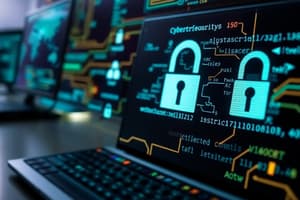Podcast
Questions and Answers
What is a key principle of the Zero Trust Architecture model?
What is a key principle of the Zero Trust Architecture model?
- Require strict identity verification for every access attempt (correct)
- Focus solely on protecting physical network infrastructure
- Implement security measures that rely on user roles
- Trust all users inside the network perimeter by default
What does the shared responsibility model in cloud security imply?
What does the shared responsibility model in cloud security imply?
- Only service providers are responsible for security
- Organizations and service providers share security responsibilities (correct)
- Security is the sole responsibility of the organization using the cloud
- User education is the only aspect of cloud security
Which of the following is NOT a focus of critical infrastructure protection?
Which of the following is NOT a focus of critical infrastructure protection?
- Maintaining the confidentiality of organizational data (correct)
- Protecting transportation networks from attacks
- Ensuring healthcare systems remain operational
- Securing power grids from cyber threats
Comprehensive strategies for cybersecurity should address which of the following?
Comprehensive strategies for cybersecurity should address which of the following?
Why is trust in computing environments becoming increasingly important?
Why is trust in computing environments becoming increasingly important?
What is the primary goal of cybersecurity?
What is the primary goal of cybersecurity?
Which of the following is a type of malware?
Which of the following is a type of malware?
What does the principle of Trustworthy Computing primarily emphasize?
What does the principle of Trustworthy Computing primarily emphasize?
What is the concept of 'Defense in Depth' in cybersecurity?
What is the concept of 'Defense in Depth' in cybersecurity?
Which term describes deceptive practices to obtain sensitive information?
Which term describes deceptive practices to obtain sensitive information?
Which is NOT a common type of cyber threat?
Which is NOT a common type of cyber threat?
What benefit does Security Awareness Training provide?
What benefit does Security Awareness Training provide?
What emerging trend is increasingly utilized in cybersecurity?
What emerging trend is increasingly utilized in cybersecurity?
Flashcards
Cybersecurity Definition
Cybersecurity Definition
Protecting systems, networks, and data from cyber threats using technologies, practices, and policies.
Cybersecurity Importance
Cybersecurity Importance
Protecting sensitive data, reducing cyberattack risks, and maintaining system integrity.
Malware
Malware
Harmful software designed to damage or exploit devices and networks.
Phishing
Phishing
Signup and view all the flashcards
Defense in Depth
Defense in Depth
Signup and view all the flashcards
Security Awareness Training
Security Awareness Training
Signup and view all the flashcards
Trustworthy Computing
Trustworthy Computing
Signup and view all the flashcards
AI and Automation
AI and Automation
Signup and view all the flashcards
Cloud Security
Cloud Security
Signup and view all the flashcards
Zero Trust
Zero Trust
Signup and view all the flashcards
Critical Infrastructure
Critical Infrastructure
Signup and view all the flashcards
Comprehensive Security
Comprehensive Security
Signup and view all the flashcards
Study Notes
Cybersecurity
- Cybersecurity protects systems, networks, and data from digital attacks.
- It involves safeguarding information from unauthorized access, theft, and damage.
- This is crucial in our increasingly interconnected world.
Trustworthy Computing
- Focuses on creating reliable, secure, and resilient computing systems.
- Emphasizes building trust through strong security and ethical practices.
Key Components of Cybersecurity
- Definition: Cybersecurity is the set of technologies, practices, and policies to protect systems and data from cyber threats.
- Importance:
- Protects sensitive data from theft and damage.
- Mitigates risks from cyberattacks, preventing financial loss, reputational harm, and legal issues.
- Maintains integrity and availability of critical infrastructure.
- Types of Cyber Threats:
- Malware: Malicious software harming or exploiting devices.
- Phishing: Deceptive attempts to gain sensitive information.
- Ransomware: Malware encrypting data and demanding payment.
- Insider Threats: Risks from individuals within an organization misusing access.
Cybersecurity Strategies
- Defense in Depth: Multiple layers of security controls to protect assets.
- Security Awareness Training: Educating employees about threats and safe practices to minimize human errors.
- Incident Response Plans: Predefined procedures to handle potential security breaches and minimize damage.
- Advanced Technologies: Leveraging AI and machine learning for real-time threat detection and response.
Trustworthy Computing Principles
- Reliability: Consistent and correct system operation under normal conditions.
- Security: Protection from unauthorized access and data integrity.
- Privacy: Safeguarding personal information with ethical and transparent data collection practices.
- Compliance: Following legal and regulatory data protection standards.
Emerging Trends in Cybersecurity
- AI and Automation: Increased use of AI tools for improved threat detection and response.
- Cloud Security: Protecting cloud-based assets as organizations increasingly use cloud environments (shared responsibility model).
- Zero Trust Architecture: Strict identity verification for all access attempts regardless of location (inside or outside network).
- Critical Infrastructure Protection: Ensuring the safety of essential services like power grids, healthcare, and transportation from cyber threats.
Conclusion
- Cybersecurity and trustworthy computing are crucial in today's digital world.
- Organizations must use comprehensive strategies addressing both technical and human factors to protect their assets and build trust.
Studying That Suits You
Use AI to generate personalized quizzes and flashcards to suit your learning preferences.




